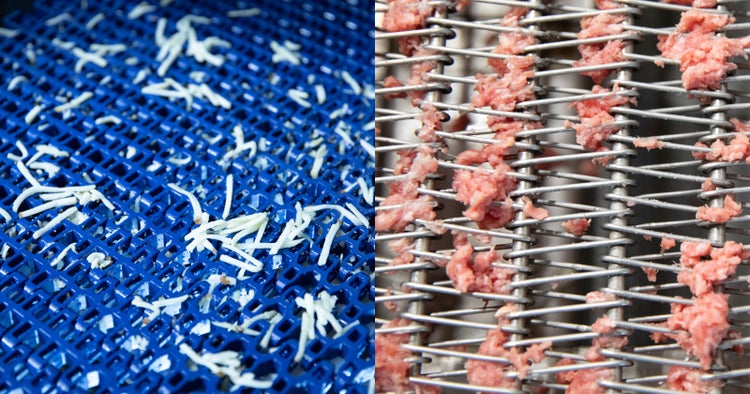The Truth About Spiral Belt Sanitation
Which material is easier to clean: metal or plastic?
- Insights
- August 20, 2021

Spiral conveyors are uniquely positioned along food processing lines. In our view, this is an area of the plant where food safety efforts and automation technologies converge.
If your facility has spirals, you understand the advantages they bring to an operation. With the right equipment and belting, spiral systems allow processors to condition various food products efficiently in a small footprint.
The downside? If these mission-critical conveyors have a problem or go down completely, it could affect your entire production line.
Cleanability is key. To maintain food safety and optimal operating conditions, spiral owners must be sure that critical system components, such as belting, can be thoroughly sanitized.
But even though modular plastic belting is widely used in spiral conveyors, some food processors claim that metal belting is easier to clean. Is that the case?
To find the truth, we set out to determine:
When applied in spiral conveyor systems, can plastic belt material be cleaned as effectively as metal belt material?

Anthony Saitta, a Food Safety Specialist with Commercial Food Sanitation, conducted an in-depth study to compare the cleanability of metal (stainless steel) belting to plastic (acetal) belting for spirals.
“It was important to approach this scientifically,” says Saitta. “Although regulatory standards are becoming more stringent, there have been multiple recalls in recent history. Understanding the facts regarding effective sanitation is crucial so that all of us can achieve our food safety goals.”
The cleaning studies were conducted in a state-of-the-art conditioning control center. This allowed Saitta to replicate the exact operational and environmental conditions commonly used in spiral freezing and cooling applications.
Method
In this study, potato hash and ground beef were applied individually to the belts. These soil types were selected based on their makeup, the processing conditions they undergo, and the prevalence of spiral freezer systems in the vegetable and meat industries.
Spiral environmental temperature was lowered to approximately -10°F (-23.3°C) and the soils had a dwell time of about three hours. Next, the system underwent a thawing process where the temperature was raised to approximately 45°F (7.2°C).

Both the metal and plastic belt materials were cleaned using clean-in-place (CIP) spray bars. The process included pre-rinse, chemical application, and post-rinse steps for two revolutions each. Belt velocity was set to approximately 30 ft/min (9.1 m/min). Spray bar setup, water temperatures, drive pump adjustments, and chemicals used were implemented to meet common industry recommendations.
A post-sanitation inspection was conducted to look for physical, chemical, and biological residue. This was followed by a clean equipment swabbing process to determine the presence or absence of microbiological residue.
Findings
Residue
After cleaning, no visible residue was observed on the Intralox modular plastic belt. However, each soil type left observable residue on the metal belt material. The forms consisted of either pieces of food or oily surface residue that remained on and between the metal belt material after cleaning.

Design
Belt design and construction contribute to cleanability. Metal belts have several, tight niche areas and catchpoints where food was found after cleaning. Additionally, even after detergent application and final rinse with high-pressure spray nozzles, oily residue remained on some of the thin, round surface areas of the metal belts.
Intralox Team Tip: In choosing a spiral belt, consider more than just material. There are clear differences in how the design and engineering of modular plastic belting stacks up against metal belting.
Counts
Most aerobic plate count results were in the acceptable range for both metal and plastic belt materials, though slightly higher counts were observed on the metal belt material.

Watch Anthony Saitta, Commercial Food Sanitation Food Safety Specialist, test and compare the cleanability of metal and plastic belt material. See the results for yourself.
Conclusion
The goal was to determine whether plastic belt material could be cleaned as effectively as metal belting. The CIP method used resulted in no visible residue on the modular plastic belt material, however, some visible residue remained on/between the metal belt material.
The study revealed that niche points relative to the belt design and soil types were critical factors in how the tested belts performed. Food and residue did not seem to stick to or hang on the plastic material as was observed with the metal belt material.
Plastic belting displayed characteristics more desirable than metal when cleaning. Modular plastic belting—by design—includes fewer niche, catch, sandwich, and sticking points than metal belts. Also, molded plastic has a smooth carrying surface ideal for effective cleaning.
Commercial Food Sanitation Food Safety Specialist
While some food manufacturers have believed metal belt material is inherently more cleanable than plastic, the testing didn’t support that claim.
Not only does plastic belt material demonstrate similar, and, in some applications, more favorable cleanability, results from Saitta’s study also show that design and engineering contribute just as much to how well a belt can be cleaned.
Based on this study, the metal belts tested displayed factors that put them at a disadvantage for their cleanability. The results showed the Intralox modular plastic belting, with its material properties and innovative hygienic design, can be cleaned more easily than metal belting in spiral conveyors.
With food safety on the line for your business every day, it’s vital to rely on data and results over common claims… especially before adding that new spiral conveyor system to your facility.
To learn more about Intralox's solutions for your mission critical, conditioning applications, visit our Spirals page.
